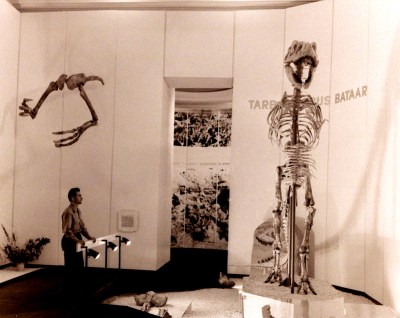History

In 1968, professor Zofia Kielan-Jaworowska organised an exhibition titled ‘Dinosaurs of the Gobi Desert’ in the halls of the Palace of Culture and Science in Warsaw. The exhibition, which presented the findings of Polish-Mongolian palaeontological expeditions to the Gobi Desert, was open until 1984.

In 1984, the Institute of Paleobiology took over exhibition halls previously occupied by the Institute of Zoology, Polish Academy of Sciences, located in the Youth Palace (part of the Palace of Culture of Science), establishing the Museum of Evolution. In 1985, a permanent exhibition called ‘Evolution on Land’ (according to the concept of Zofia Kielan-Jaworowska, with input from Andrzej Sulimski and a team from the Institute of Paleobiology) was opened to the public. The exhibition featured numerous specimens collected during the expeditions to Mongolia. Part of the exhibition was also devoted to modern animals, in particular insects and birds, with specimens from the collections of the Institute and Museum of Zoology on display.
In 2001, a new exhibition showcasing the Late Triassic reptiles and amphibians discovered in Krasiejów near Opole was opened. The exhibition comprises both original fossil material from the Krasiejów site, as well as life-reconstructions of land and aquatic animals found at the locality.
In 2003, the anthropology section of the Museum’s exhibition was expanded to include a life reconstruction of the famous Australopithecus specimen ‘Lucy’.

In 2005, the permanent exhibition of the Museum of Evolution underwent further development. The most significant additions included two new skeletal reconstructions of the Mongolian dinosaurs Tarbosaurus and Opisthocoelicaudia, based on the most up-to-date scientific information on their anatomy.
In 2009, the permanent exhibition of the Museum of Evolution was further expanded to coincide with the 150 anniversary of the publication of Charles Darwins’ ‘On the Origin of Species’. The new exhibit, titled ‘Who Gave Me Legs? The Conquest of Land by Vertebrates’, featured a Devonian swamp diorama with models of the famous tetrapodomorph Tiktaalik as its centrepiece.
Translated by Andrzej Wolniewicz
